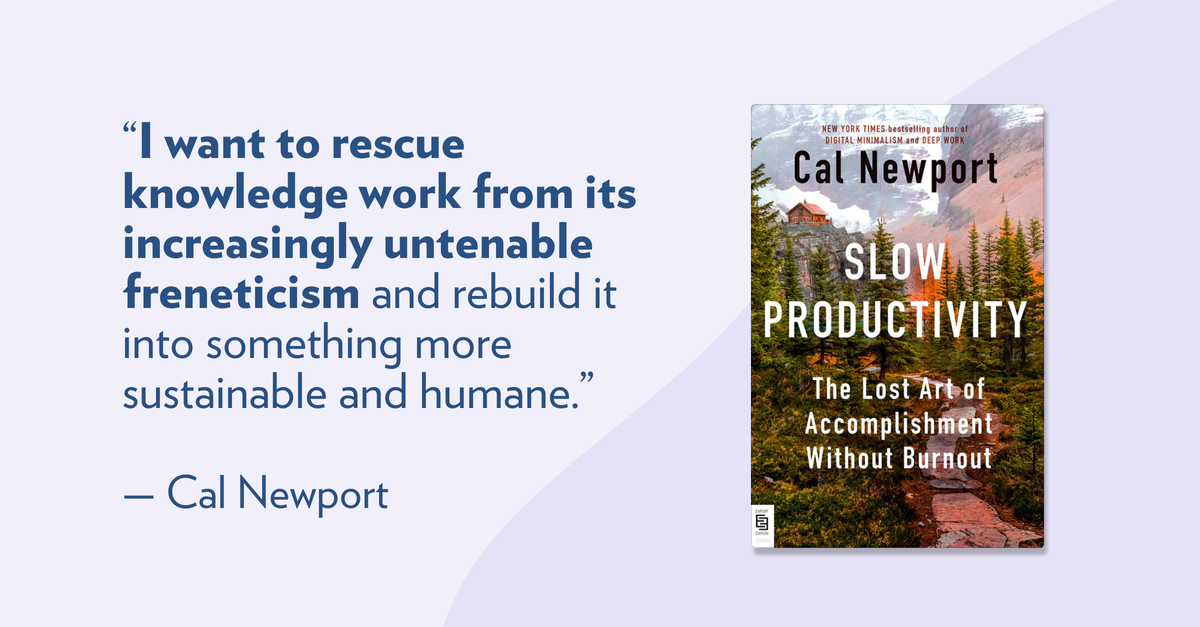Book Review: Slow Productivity
In his newest book, Cal Newport talks about why slowing down is the secret to creating a happier, healthier, and more productive workplace. Here's why the book is worth reading.

“... knowledge workers were exhausted … people were overwhelmed … the situation seemed dark, but as I continued my own research on this topic, a glimmer of optimism emerged, sparked by [slowing down]”.
TL;DR
Slow Productivity is worth your time. People-first practitioners will nod their heads in agreement with Newport’s core philosophy of creating sustainable and meaningful work. At points, Slow Productivity feels like marketing material for us. Share the concepts with your team!
In contrast to Deep Work, is Slow Productivity powerful enough to cause "slow" to become a pillar of the People-First Community? I don’t think so. Newport has difficulty connecting his examples to workplace chaos. Many of the examples he uses, including Georgia O’Keefe’s creative brilliance or Galileo’s profound impact on science, may seem a bit out of reach when we’re simply trying to silence Microsoft Teams pings.
The importance of Cal Newport's influence on the People-First Community cannot be overstated. As the author of Deep Work, his thought leadership forms one of the six core criteria of people-first companies.
His latest book, Slow Productivity, is a great resource for team leaders and business owners, demonstrating the value of establishing a slower pace in our work. Principally, slowing down is vital to creating sustainable work environments that allow your teams to be happy and productive.
“I want to rescue knowledge work from its increasingly untenable freneticism and rebuild it into something more sustainable and humane.”
Let’s take a look at some highlights from the book, including a critique of Newport’s obsession with quality. And then, for those of us not writing the next literary masterpiece, I’ve provided two suggestions to incorporate slowness into the workplace.
Slow is good
It’s worth saying again: Slow is a good thing.
Slow Productivity shows “slow” as a source of strength. This is no small feat! In the business world speed is so often celebrated, while slow is stigmatized.
Newport allows us to toss out the negative connotations of “slow,” and embrace patience and intentionality.
The relentless overload that’s wearing us down is generated by a belief that “good” work requires increasing busyness—faster responses to emails and chats, more meetings, more tasks, more hours. But when we look closer at this premise, we fail to find a firm foundation.
The foundations of the people-first movement understand that when we’re organized and metered in our work, people are happier, healthier and, Newport argues, more productive.
I cannot stress enough how helpful it is for leaders to cheer their team for being productive, slowly.
Pseudo-productivity
This is what ultimately matters: where you end up, not the speed at which you get there, or the number of people you impress with your jittery busyness along the way.
The first section of the book devotes itself to defining “pseudo-productivity”. Newport takes aim at the current state of knowledge work—calling it performative. That’s to say—simply quantifying anything (i.e., emails responded to) as looking like work, versus being productive.
People-first companies know exactly what performative works smells like:
- Forwarded emails with nothing more than “see below”. Yuck!
- Meeting invites with no agenda. Gasp!
- DMs asking “can you talk right now” … OMG!
Throughout this introduction, you and your team members will surely think, “I’m so glad I work at a people-first company!” In fact, many of us are encouraging our teams to work “less”.
Slow Productivity provides us with a language to show why people-first companies are so important.
What is quality?
After defining pseudo-productivity, Newport dives into the three principles of Slow Productivity:
- Do Fewer Things
- Work at a Natural Pace
- Obsess Over Quality
(The first two principles are tightly coupled to what we’ve already learned in Deep Work. So we’ll fast-forward to the third.)
I urge extreme caution against obsessing over quality. Throughout the book, Newport shares examples of absolute and celebrated masters of their craft: Lin-Manuel Miranda, Jane Austen, Marie Curie, Benjamin Franklin, et. al.
And thus the slippery slope begins: I want my TPS reports to read like Pride and Prejudice! Our quarterly report should entertain clients like Act II of Hamilton!
Newport even goes so far as to use Steve Jobs, broadly understood as an extremely demanding manager, to prove his point. … I’m not convinced Jobs is a good fit for the people-first principles. (See more: Let's talk about the myth of Healthy Tension)
Team leaders and managers must particularly steer clear of defining success using ambiguous, subjective terms like “high quality.”
Of course, companies shouldn’t ship sh*t. But keep in mind the pressure on team members if they feel they’re being asked to hit home runs in every at-bat.
Suggestions
Slow it down
Newport doesn’t touch too deeply on how we can tone down chaotic, “fast” environments with team members, clients, or suppliers.
To me, it’s all about spotting (fake) urgency in our day-to-day routine and then taking deliberate action to get work done calmly, limiting unnecessary interruptions for your team. Let’s look at a fake (but kinda real, too!) example to dissect:
- Client [via email 4:52 p.m.]: Can we make the logo bigger?
- Account Manager: Yes, we’ll get right on that.
- Client [via email]: Thank you!
… - Account Exec [via Slack DM 4:53 p.m.]: We need to make the logo bigger.
- Designer: On it.
… - Designer [via Slack DM at 6:59 p.m.]: Here’s the file.
- AE: Thanks, you’re the best.
… - AE [via email at 7 p.m.]: Here’s the updated logo.
… - Client [next day at 3:02 p.m.]: Thanks!
The simple scenario above is highly likely to create a chain reaction of chaos. When the default mode is ASAP and right now, unintended urgency emerges and disrupts our team—and our productivity.
Here’s my advice: slow it down with the words we use. Most critically, don’t be afraid to ask:
- When is the request due?
- What is driving any urgency?
Here’s an updated example:
- AM: Yes, we can do that. When do you need these changes? Is there anything urgent on your end we should be aware of?
And now we can slow it down even further once we have a sense for timing:
- AM: I’m going to speak to the team right away and I’ll let you know when we can expect to have this done.
Finally, the people-first Jedi Masters who are deeply intertwined with async work may respond as follows:
- AM: I speak with the design team tomorrow at 10 a.m., I’ll get this update to them at that time. Does that work okay for you? Typically this type of change is less than a few hours, but I need to see what else is on their plate.
When we remove the urgency—particularly avoiding hot potato communications within our teams—the slower process is often much more productive.
Obsess over objectives
A great company is defined by its people, working together. This is much less about bespoke brilliance, and much more about sustainable, supportive environments that we can rely upon for great work.
The most important way for managers to avoid the “quality” trap is to ruthlessly and objectively define success. Said another way, create high-quality objectives for your team.
The people-first leader must ask herself: are the goals I’m setting for my team SMART?
If our teammates cannot obviously affect the outcomes we’re setting for them—our job isn’t finished yet. Keep at it and once success is clearly achievable, we’ve created an environment that breeds success.
High-quality objectives are directly in support of the PFJ principle of professional development. We can provide helpful guidance, unending positive feedback, and continued evolution in their roles.
Like that we’re not obsessing over the next great idea, but methodically watching the team breathe meaningful life into the business.
Slow is smooth
Towards the end of Slow Productivity, Newport shares the adage:
Hardwood grows slowly.
There are dozens of similar phrases giving props to being slow:
- Slow and steady wins the race.
- Haste makes waste.
- Better late than never.
- One step at a time.
Slow Productivity provides us with a broad message in the working world to embrace “slow” as a positive. By focusing on reducing (or removing) chaos and freneticism, slowing down creates sustainable environments. The alignment with people-first principles is unquestionable.
Slow is smooth. Smooth is fast.
Tom Buchok is a hands-on management coach who focuses on people-first principles. Learn more at buchok.com.
